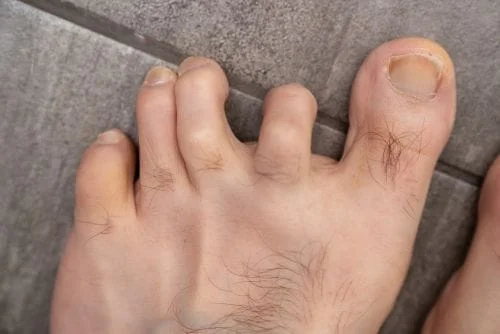Hammertoes
Hammertoes
What Is Hammertoe?
A hammertoe is a deformity in which the toe of the foot, usually the second, third, or fourth toe, is bent downward at an angle like a hammer.
Hammertoes are usually formed by wearing shoes that are ill-fitting. If left untreated, they can lead to a wide variety of issues, from foot pain to the formation of corns, calluses, and bunions.
These problems can be prevented by seeing a foot specialist and receiving treatment.
Symptoms
What Are the Symptoms?
You will likely spot the issue of hammertoe if you’re having experience with the following:
- Toe may not straighten out and appear bent at an angle
- The formation of corns or blisters on the top of the toe
- Inability to wiggle or move the affected toe
- Difficulty walking due to the pain
Causes
Footwear
When you wear high heels or shoes that are tight in the toe box, they are often the point of origin for hammertoes. When your toes are stuck in an uncomfortable position for a long time, the muscles that allow your toes to extend become tight. Over time, they won’t be able to stretch out as they used to.
The tightening can eventually lead to hammertoe, as well as corns and calluses that can further irritate the condition.
Age
Hammertoe can be quite common in adults, especially those who wear high-heeled shoes. Adults who begin to experience the development of hammertoe may also be experiencing corns and calluses from years of being on their feet.
Toe Length/Foot Posture
If your toes are longer, the likelihood of you developing hammertoes may increase if you’re consistently wearing tight or heeled shoes. If you already have an underlying foot condition, such as flat feet or bunions, hammertoe may develop as a result.
Past Injuries
Any early trauma or injuries to the toe can later result in the development of hammertoe. These injuries can happen to athletes, dancers, or other professions that cause strain on the feet.
Other Conditions
There are other conditions that can increase the risk factor of hammertoe:
- Diabetes
- Neuromuscular conditions
- Muscle imbalance
- Tendon imbalance
- Inflammatory joint diseases, such as arthritis
Treatments
What Kind of Treatments?
Hammertoe can be treated by a foot specialist in its earlier stages of development. These treatments can involve stretching, strengthening, and restoring flexibility back to the impacted toes.
There are numerous amounts of treatment options, such as:
- Stretching and strengthening your toe and foot muscles. This can aid in keeping your toes straight and your tendons looser.
- Foot exercises to build strength and flexibility.
- A change in footwear. Wearing shoes that fit properly will play a crucial role in the prevention or treatment of hammertoes. Choose footwear that promotes muscle balance and weight distribution. Avoid shoes that have a narrow toe box or high heels.
- Custom orthotics: Help in correcting any faulty foot mechanics, such as hammertoes.
- Foot splints: To aid in stretching out the tendons and keeping the toe straight.
- Corn pads: Corns may form because of the hammertoes, which is why a cord pad may add some relief.
If hammertoes are left untreated, it can lead to serious risk factors that may involve surgery to correct.
Surgical Treatments
Surgery may be an option if the non-surgical treatment doesn’t alleviate any of the issues. Treatments can include the following:
- Tendon lengthening: If the hammertoe is still flexible, this option may work for you. It involves lengthening the tendons that are causing an imbalance.
- Tendon transfer: This procedure involves transferring the tendons from the bottom to the top of the tendon to pull the bent toe joint straight.
- Arthrodesis: This surgery works for those that have rigid hammertoes and involves fusion of the joints. The surgeon will remove a small portion of the bone in the toe joint, which allows it to extend or straighten. Doctors may often combine this method with tendon lengthening.
Risk Factors
You may be wondering about all the risk factors that can lead to developing a hammertoe. The factors include:
- Wearing shoes that don’t fit properly
- Arthritis that affects the joints of the toe
- Flat arches
- Certain toes that are longer than others
- Deformities, such as bunions or high arches - these conditions can take up a lot of room in your shoes and cause your toes to become crowded.
Prevention
How To Prevent Hammertoes?
Shoes that are restrictive in space are the most common cause of hammertoe. However, there are specific kinds of shoes that can prevent the risk. Look for flat or low-heeled shoes, as they leave enough space for your toes, and stay away from shoes that are:
- High heeled
- Pumps
- Pointed
- Narrow
- Tight
Stick to shoes with laces, as they offer more room for control over the tightness of the footwear.
Orthotics are useful for not only treating hammertoes but preventing them as well. They will correct any biomechanical issues that might lead to developing a hammertoe. If you need assistance in finding the right footwear, our skilled foot specialists can lend a hand.
Regularly stretching and strengthening the muscles and joints in your feet or toes can do wonders. Practicing this method, even if you don’t have a hammertoe, can go a long way in preventing it in your future.
Contact our knowledgeable foot specialists today if you’re experiencing pain and difficulty walking due to a serious hammertoe. They can also assist in providing the right footwear necessary to curve the risk of developing hammertoes. No appointment is required.






